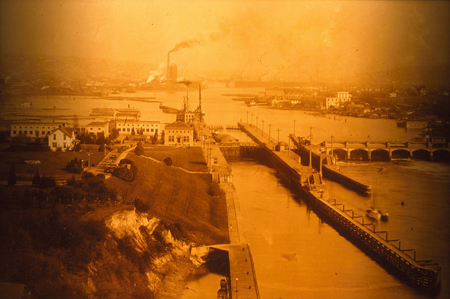Ballard resident Jim Broumley is taking on a monster of a project — to create an archive of the Ballard Locks and Carl English Gardens from scratch. Jim thinks there are nearly 3,000 uncataloged photos and slides.

By the end of summer, Jim wants to inventory all photo collections, documents, and artifacts. His plan is to create a volunteer organization to raise funds for specific equipment and supplies, recruit volunteers for the history project and gardens, scan all photos and slides in the collections and conduct several oral history interviews of former staff and volunteers. In the end, his goal is to put all the photos online. If you’d like to help Jim with this unique project, you can email him at jim@ridinthewave.com and check out his Roving Historian blog. Jim is passionate about this project and took it on as an internship to finish his MA in History from Shippensburg University in Pennsylvania. (Photo courtesy the Army Corps of Engineers and Jim Broumley.)
11 thoughts to “Help create an archive of the Locks”
Leave a Reply
You must be logged in to post a comment.

Nice photo. What is the big smokestack in the distance?
I think that's Gas Works.
That smokestack is seen in quite a few pictures from different directions. It is usually generically identified as a lumber mill. I think, because of the structure that looks like a silo beside the smokestack, it is the Seattle Cedar Lumber Mfg. Co. There are close-up pictures of it on page 107 of the Passport To Ballard book published by the Ballard Historical Society.
Correction, published by the Ballard News-Tribune.
The GasWorks came along much, much later. At one time Ballard was “The Shingle Capital of the World” because of all the cedar shingle mills as well as lumber mills. From the 1890s until 1962, Ballard was well known for its mills. When last mill burned down, it could be seen for miles. Now all the mill sites are either marinas, restaurants, or (on the Queen Ann side of the bridge) mini-storage units. Check out my book, “Early Ballard” by Arcadia Publishing. BTW, Seattle Times book reviewer Adam Woog wrote a book on the locks called, amazingly enough: “Ballard Locks.”
OK.. Maybe Gas Works came later, but isn't this picture pointed east? Isn't the smoke stack about the same location that Gas Works Park is now? Or is Gas Works further down?
Thanks for the info Julie! I read your book when I first moved here and really enjoyed it.
BallardMarci: You're right it is looking east, but Gas Works is farther down I think. See my response to Woolly above. I wish the photograph was online. The smokestack and silo are pretty distinctive, I'm confident it's the Seattle Cedar Lumber Co.
It's facing east, but think about how far away Gas Works Park is. And do I see the original Ballard Bridge there? It seems to me like the smokestack is approximately where the Bit Tavern is….
Marci; look at a map of Seattle. See where the ship canal is? See where Lake Union is? See how far Ballard is from Lake Union? The GasWorks are on Lake Union. Until 1917 there was no real outlet from Lake Washington into Lake union and then into the Sound other than a creek. The mills extended all the way to Fremont and then on the other side on the Queen Anne side of the water. There were mills in Fremont as well. (the source of Suzie Burke's family's money.) The tall smokestacks of the 14 mills in Ballard could be seen for miles away. The mills of Ballard extended all the way to where Fred Meyer is now.
Actually, the site of the current Fred Meyer was in fact the ironworks plant, and nearby was the dump!
There were in fact shipyards at the site of the locks, until they were lost when the locks were built. Interestingly enough, since the locks raised the water level 14 feet, (and many of the mills were condemned) one enterprising mill owner built a “cofferdam” around his mill; the actual mill was well BELOW the new water level!
BTW, when I was doing research for the Early Ballard book I spent a lot of time down at the Locks looking through their archives and scanning pictures. The people down there could not be nicer, friendlier or more accomodating. The best part of helping them catalog their collection is that you get to do it in one of the most historic, beautiful buildings in the city of Seattle, while watching boat traffic go by, and you get to spend some time in arguably one of the finest gardens in the Pacific Northwest.
Update: We had a great response to this post. The project now has eight volunteers and several waiting in the wings for weekend access. If you'd like to help out, give us a holler. Everyone is welcome and there is lots of work to do. ;-)